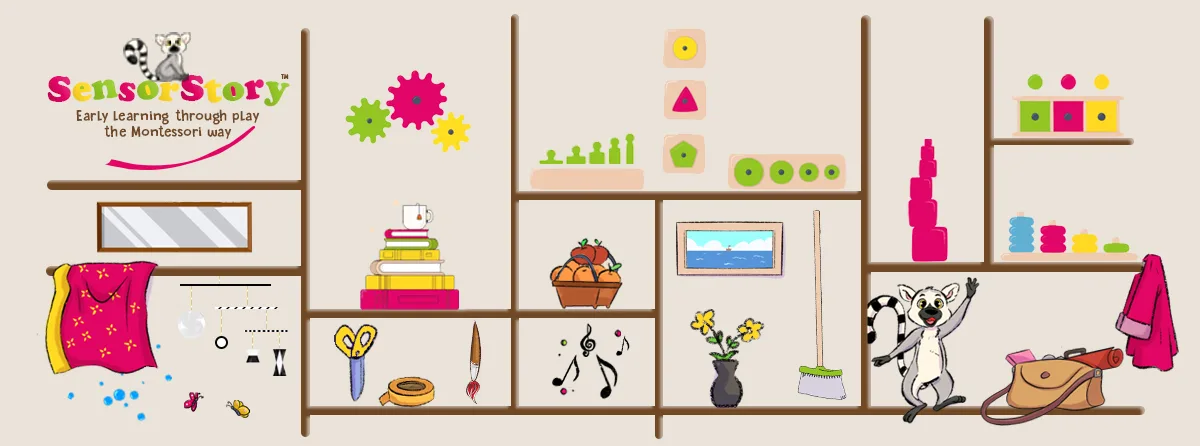We've put together a detailed list of at-home Montessori-aligned activities suitable for a 4-month-old.
Here you will see age-appropriate activities for all areas, in our Ultimate Series Of Activities to try at home, where the emphasis is on providing a prepared environment and allowing the child to actively engage in self-directed learning.
So what is my child working on mastering at this age?
Between the 3-6 month age, baby's primary focus is on sensorimotor development, encouraging exploration through senses such as touch, sight, and hearing. Your baby is also beginning to develop basic motor skills, including grasping and reaching. Language exposure is important, and caregivers are encouraged to provide a language-rich environment. Additionally, fostering a sense of security and routine lays the foundation for your child's overall well-being.

1. Sensory Exploration:
* Fabric Texture Board: Create a fabric texture board with different materials for tactile stimulation.
* Provide a soft sensory mat with different textures for tactile exploration.
* Introduce a basket with safe, natural objects like fabric squares, soft brushes, or rattles.
* Soft Cloth Teething Toys: Provide cloth teething toys for gentle chewing and tactile exploration.
* Allow your baby to explore a variety of safe textures, such as soft fabrics and plush toys.
2. Visual Stimulation:
* Hang a Montessori mobile above the baby's chest; Bell on a Rope is perfect for this age.
* Offer picture cards with clear patterns and beautiful illustrations for visual stimulation.
* Introduce a baby-safe mirror for baby to observe their own reflection.
* Large Soft Ball with Patterns: Introduce a soft, fabric-covered ball with contrasting patterns for visual tracking.
3. Auditory Stimulation:
* Soft Crinkly Toys: Offer toys with crinkly material for auditory and tactile engagement.
* Play soft, gentle music or lullabies during calm moments.
* Use soft rattles or toys with gentle sounds for auditory exploration.
* Engage in soothing, rhythmic sounds or gentle singing during daily routines.
4. Tummy Time and Movement:
* Start with short, supervised tummy time sessions to promote neck and upper body strength.
* Use a rolled-up blanket or small cushion to support baby during tummy time.
* Soft Play Mat: Provide a soft play mat for tummy time and movement exploration.
* Place visually interesting toys within baby's reach to encourage reaching and swatting.
* Gradually increase tummy time duration as your baby becomes more comfortable.
5. Grasping and Reaching:
* Offer soft, graspable toys for your baby to hold and explore.
* Introduce a Montessori Grasp ball.
* Encourage reaching for hanging toys on a baby gym.
6. Exploration with Safe Objects and Mouthing:
* Provide a small basket of safe, non-toxic objects for your baby to explore with their hands and mouth.
* Offer a teething toy or soft fabric for mouthing and sensory exploration.
* Explore baby-safe household items, such as a soft brush or cloth.
7. Interaction with Faces:
* Engage in face-to-face interactions, making eye contact and expressing warmth.
* Encourage your baby to imitate simple facial expressions.
* Offer a soft, plush toy with a friendly face for baby to focus on.
* Use a soft-touch book with photos of diverse baby faces, showing happy, sad, sleepy faces. You can make the same expressions.
8. Reading and Storytelling:
* Interactive Soft Books: Introduce soft books with crinkly pages or hidden textures for engagement.
* Use soft, cloth or board books with simple patterns and beautiful photos.
* Allow baby time to look at and touch the pages during reading time.
* Incorporate soft, rhythmic reading to create a positive association with books and language
9. Mirror Play:
* Introduce a baby-safe mirror for self-recognition and exploration.
* Encourage your baby to reach for their reflection and explore their own hands and face.
* Use the mirror during tummy time or once they begin sitting.
10. Nature and Outdoor Exposure:
* Soft Fabric Animals: Provide soft fabric animal toys for gentle play.
* Soft Outdoor Blanket: Use a soft blanket for outdoor play and relaxation.
* Allow baby to feel the warmth of sunlight and a gentle breeze during outdoor time. Note: babies under 6 months old should be kept out of direct sunlight.
* Encourgae your baby to feel grass or leaves during outdoor play.
* Introduce safe natural items like pinecones or fabric versions for visual and tactile stimulation.
11. The Whole Child Development:
* Attend our weekly SensorStory Baby and Toddler Montessori parent-child sensory classes! Follow this link to enrol your infant here.
We hope we have given you some inpiration for activities to do with your 4-month-old!
Remember, follow the child, adapting activities based on your observation of your baby's developmental stage and individual interests. The key in a Montessori environment is to provide your child with real, purposeful, and age-appropriate tools and materials that allow them to engage in activities independently and at their own pace.
Disclaimer: Adult supervision is required for any activity suggested by SensorStory. Please follow any directions and/or warnings on the labels(s) of any materials used during such activity & be aware of any potential choking hazards or allergies.
Click here to see our
Activities To Do With A 5 Month Old
FAQ.
